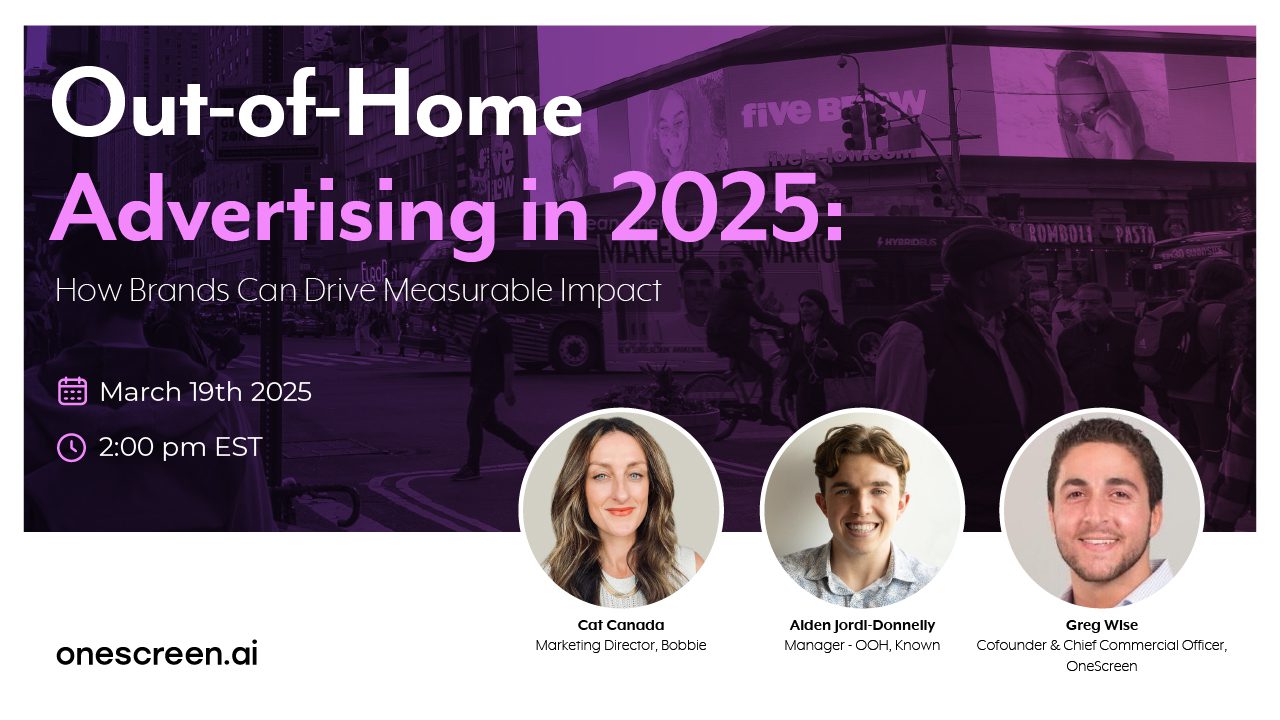For years, out-of-home (OOH) advertising was defined by its limitations: broad targeting, low accountability, and slow execution: think static billboards and subway posters with vague impression estimates.
But 2025 tells a very different story.
In a recent webinar hosted by OneScreen, industry leaders from Bobbie, Known Agency, and OneScreen explored how OOH has evolved into a performance-driven, culturally relevant, and highly measurable channel. Whether you’re a brand marketer, media buyer, or growth strategist, here’s what you need to know.
1. OOH Has Officially Entered its Performance Era
OOH is no longer just a top-of-funnel awareness tactic, it’s becoming a full-funnel performance channel.
“Out-of-home should no longer be viewed as just a brand play,” said Greg Wise, co-founder of OneScreen. “With the right data and tools, it can now sit comfortably within your performance marketing mix.”
What’s changed?
Brands can now measure:
- Lift in website traffic by geolocation using mobile ID data
- Foot traffic to retail locations from exposed audiences
- Changes in branded search volume and CPCs
- Conversion rates before, during, and after campaigns
Thanks to pixel attribution, device-level location data, and control vs. exposed audience groups, OOH’s impact is now quantifiable, something virtually impossible just a few years ago.
Why it matters:
With digital performance channels facing rising acquisition costs and privacy restrictions, marketers are actively seeking alternatives that scale. OOH is stepping in to fill that gap.
2. Creative is Everything, and Brands Are Getting Bolder
Out-of-home advertising isn’t just another impression; it’s a public statement. A visual moment that can stop people in their tracks and spark conversations far beyond the physical space.
“OOH still has this cool factor,” said Cat Canada, Director of Marketing at Bobbie. “It’s one of the few channels that earns media coverage, not just impressions.”
Bobbie’s campaign—a Times Square billboard featuring supermodel Ashley Graham combo feeding (breast and formula)—was a first-of-its-kind activation. It received widespread press and social media attention, reinforcing its brand mission and driving engagement across the funnel.
What worked?
- It was timely and culturally relevant
- It took a stand on a topic that aligned with brand values
- It used the OOH placement as a content engine, not just an ad
Pro tip: Use OOH placements to create viral or PR-worthy moments. Document them with photo and video content, then amplify them across social, email, and paid channels.
3. Programmatic OOH Offers Speed, Scale, and Smarter Targeting
Historically, OOH campaigns took weeks to plan and execute. But with the rise of programmatic buying, marketers can now launch geographically targeted campaigns in a matter of days or even hours.
“If you’re trying to cover a national campaign and you have a week to do it, programmatic is your best bet,” said Aidan Jordi-Donnelly, OOH Manager at Known.
What makes it powerful?
- Access to vast inventories instantly
- Ability to layer audience data (age, interests, behaviors)
- Real-time creative swaps or A/B tests
- Regional or zip-level targeting without complex vendor coordination
While programmatic often comes at a higher CPM, the efficiency and precision can make it a worthwhile tradeoff, especially for time-sensitive or multi-market campaigns.
Caveat: Programmatic inventory isn’t always guaranteed placement, and static formats are typically booked directly. Experts recommend a blended strategy combining static and digital, direct and programmatic.
4. Experiential and Place-Based Campaigns Are Surging
OOH is no longer limited to billboards and bus stops. There’s a growing appetite for experiential, mobile, and place-based formats, from wrapped vehicles to pop-up activations and digital kiosks inside stores.
“OOH thrives at the intersection of audience and context,” Greg explained. “Experiential lets you meet your customers in highly specific, meaningful environments.”
Examples:
- A food delivery brand wrapping EVs near college campuses
- A fintech startup activating with street teams at tech conferences
- A CPG brand advertising on screens inside the point-of-sale environment
For niche audiences like Bobbie’s (parents of infants), place-based media allows for hyper-targeting in high-relevance settings—like pediatric offices, baby supply stores, or lactation clinics.
Pro tip: Always validate inventory and audience data. Not all place-based media is MRC-accredited or audited by Geopath, so work with experienced partners to avoid wasted spend.
5. OOH Isn’t Just a Tactic: It’s an Impactful Channel in Your Marketing Stack
Cat described their Times Square billboard as “another marketing channel,” just like email or paid social. They refresh the creative monthly, treating it as part of a dynamic, always-on media mix.
More brands are starting to think this way.
OOH is no longer a one-off stunt; it’s an integrated part of the omnichannel customer journey. And when connected with other platforms (via retargeting, QR codes, or branded search strategies), its impact multiplies.
Use cases:
- Combine with paid social to retarget exposed audiences
- Use QR codes or unique URLs for offline-to-online tracking
- Coordinate messaging across OOH, email, and influencer channels for launch moments
OOH works best when tied to your broader narrative, not siloed off as a stand-alone effort.
What’s Next: AI, Attribution, and Always-On Thinking
As the panel wrapped up, each expert gave their prediction for the future of OOH:
- Cat predicted brands will get even bolder, using OOH to make cultural statements and spark dialogue.
- Aidan sees a surge in AI-powered targeting and experiential formats.
- Greg believes OOH will become an always-on channel, tightly integrated with digital marketing and measured in real-time.
What they all agreed on: the era of generic billboards and gut-based media planning is over.
OOH in 2025 is smart, strategic, measurable, and bold, and it belongs in every marketer’s toolkit.
Be sure to check out next month’s OOH webinar on April 8th, where we talk with Meghan Reynolds of Oura Ring to get ahead of holiday marketing budgets and how data-driven OOH can be the missing piece to a complete marketing mix that drives revenue during Black Friday and beyond.
